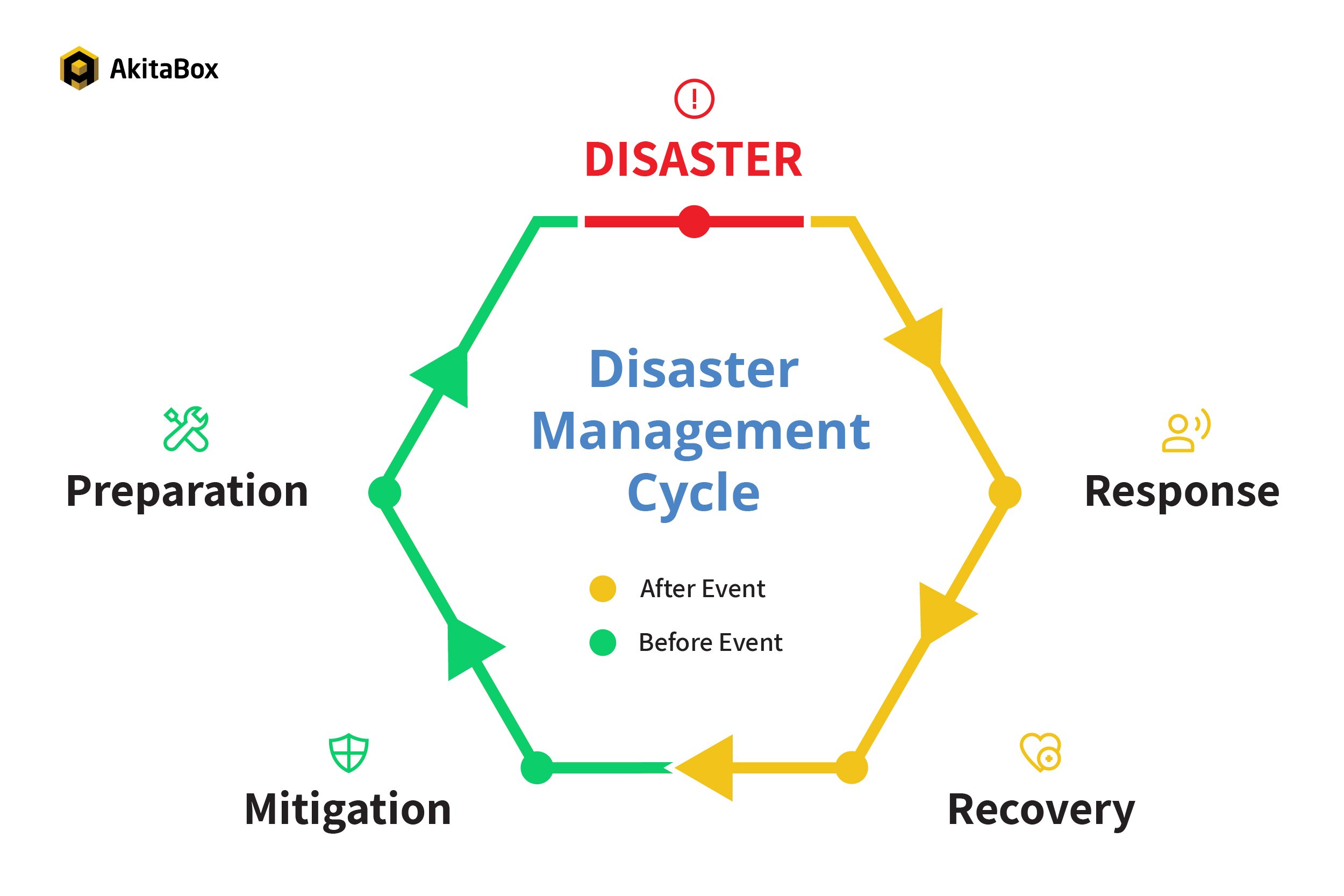What is Disaster Management? Preparation, Cycles, Types, Early Warnings
Table of Contents

- jaro education
- 12, June 2024
- 10:00 am
Disaster management is a process that deals with the adverse effects of disasters in an all-inclusive approach and systematic way. It includes planning, organizing, coordinating, and carrying out measures to mitigate, prepare for, respond to, and recover from the impact of disasters.
This multidisciplinary task involves the participation of government agencies, non-governmental organizations, interest groups, communities, and individuals to manage and reduce disaster risks. Disaster management‘s work is to mitigate vulnerability while attempting to avoid or mitigate the effects or consequences of hazards that are either natural or human-made. When disaster management is effectively applied, it will, in turn, save human lives, property under consideration, conservation, and the environment. Communities can always achieve quicker and more efficient production by embracing and applying robust disaster management.
In this blog, we will delve into the various facets of disaster management. We will begin with the crucial steps in disaster preparation, followed by an exploration of the disaster management cycle. We will then classify and discuss different types of disasters and conclude with the importance of early warning systems in mitigating disaster impacts. By understanding these components, we can better appreciate the comprehensive nature of disaster management and the critical role it.
What is Disaster Management?
Disaster management is the organized effort to handle and mitigate the adverse effects of disasters. This includes preparing for, responding to, and recovering from disasters, to minimize the impact on human life, property, and the environment. Disaster management involves various activities, including risk assessment, emergency response, resource coordination, and recovery planning. It is a multidisciplinary field integrating knowledge and practices from various sectors, such as public health, engineering, environmental science, and social sciences.
Key Objectives and Goals
Risk Reduction
- Identify Hazards: Understand potential dangers and their impacts.
- Assess Vulnerabilities: Analyze how susceptible communities and infrastructure are to these hazards.
- Mitigation: Implement measures to reduce risks, such as building flood defenses and enforcing safety codes.
Preparedness
- Emergency Planning: Develop plans detailing roles and responsibilities during a disaster.
- Training and Drills: Conduct regular training and drills for responders and the public.
- Resource Management: Ensure availability and accessibility of essential resources like food, water, and medical supplies.
Effective Response
- Rapid Deployment: Quickly mobilize emergency services and relief efforts.
- Coordination and Communication: Establish clear communication channels among responders, agencies, and the public.
- Life-saving Measures: Provide immediate medical care and essential services to those affected.
Recovery and Rehabilitation
- Assess Damage: Evaluate the extent of damage to infrastructure and property.
- Reconstruction: Rebuild homes and infrastructure, incorporating resilience measures.
- Support Services: Offer psychological, social, and financial support to help people recover.
Importance of a Systematic Approach
- Comprehensive Coverage: A systematic approach ensures all phases—prevention, preparedness, response, and recovery—are covered, reducing the overall impact of disasters.
- Resource Optimization: Efficient use of resources, such as funds and equipment, ensures they are available when and where they are needed most.
- Coordination and Collaboration: Involve multiple stakeholders working together, ensuring a unified and effective response.
- Enhanced Resilience: Continuous improvement of strategies based on past experiences helps communities become more resilient to future disasters.
- Public Safety and Well-being: The main aim is to protect people and ensure their safety and well-being by reducing vulnerabilities and enhancing response capabilities.
Phases of Disaster Management
The phases of disaster management encompass a comprehensive approach to reducing the impact of disasters through mitigation, preparedness, response, and recovery. Each phase plays a critical role in safeguarding lives, minimizing damage, and ensuring a swift and effective recovery process.
Mitigation
- Definition: Mitigation involves taking steps to reduce the impact of disasters before they occur. It focuses on long-term measures to protect lives and property.
- Importance: Effective mitigation reduces the severity of the disaster’s effects, decreases the need for extensive emergency response, and can save lives and reduce economic losses.
Examples of Mitigation Measures
- Structural Measures: Building earthquake-resistant structures, constructing flood levees, and retrofitting buildings to withstand hurricanes.
- Non-Structural Measures: Implementing land-use planning and zoning laws, enforcing building codes, and conducting public education and awareness campaigns.
- Environmental Measures: Preserving wetlands and forests to act as natural buffers, and restoring ecosystems to maintain natural defenses against disasters.
Preparedness
- Definition: Preparedness involves planning and preparing for disasters to ensure a coordinated and effective response. It includes measures to ensure readiness and the ability to manage a disaster situation effectively.
- Significance: Preparedness helps communities and individuals respond quickly and effectively when a disaster occurs, minimizing the impact and facilitating a faster recovery.
Steps Involved in Preparedness
- Risk Assessment: Identification of all the hazards and an assessment of risks on the above hazards.
- Emergency Planning: Formulation of preparation, response, and evacuation plans and communication.
- Resource Allocation: Provision of resources as regards foodstuffs, water, medical supplies, and emergency shelter.
- Training and Drills: Conducting regular training sessions and disaster drills for emergency responders and the community.
- Public Education: Informing the public about disaster risks and preparedness measures through campaigns and educational programs.
Response
Immediate Actions Post-Disaster
- Search and Rescue: Conducting search and rescue operations to save lives.
- Medical Assistance: Providing medical care to the injured and ensuring the availability of medical supplies.
- Emergency Shelter: Setting up temporary shelters for displaced individuals.
- Basic Needs Provision: Distributing food, water, and other essential supplies.
Coordination and Communication Strategies
- Incident Command System (ICS): Implementing a standardized approach to the command, control, and coordination of emergency response.
- Inter-Agency Coordination: Facilitating cooperation among different agencies and organizations involved in the response.
- Communication Systems: Ensuring effective communication channels between responders, authorities, and the affected population.
- Public Information: Disseminating accurate and timely information to the public to prevent panic and ensure compliance with safety measures.
Recovery
Short-Term and Long-Term Recovery Processes
- Short-Term Recovery: Involves immediate actions to restore essential services, such as electricity, water, and transportation. It also includes debris removal and providing temporary housing.
- Long-Term Recovery: Focuses on rebuilding and improving infrastructure, economic recovery, and addressing the long-term needs of the affected population.
Rehabilitation and Reconstruction Efforts
- Rehabilitation: Providing psychological support and counseling services to disaster survivors, and restoring livelihoods through job creation and economic support.
- Reconstruction: Rebuilding damaged infrastructure and homes, often with improved standards to reduce future risks. This phase also involves reviewing and improving disaster management plans and policies based on lessons learned.
This detailed breakdown of each phase highlights the comprehensive nature of disaster management and the importance of a coordinated and well-prepared approach to minimize the impacts of disasters and facilitate effective recovery.
Types of Disasters
Disasters can be broadly categorized into natural and man-made events, each causing significant disruption and damage. Understanding these types helps in developing effective strategies for prevention, preparedness, and response.
Natural Disasters
Earthquakes
- Description: Earthquakes are sudden and violent shaking of the ground resulting from movements within the Earth’s crust. These seismic activities occur due to the release of energy from the Earth’s tectonic plates as they shift and grind against each other. The point within the Earth where the quake starts is called the focus, while the point directly above it on the surface is known as the epicenter.
- Impact: Earthquakes can have devastating effects on communities and infrastructure. The immediate impact includes significant structural damage to buildings, bridges, and roads, leading to injuries and loss of life. In densely populated areas, the risk of casualties is higher due to the collapse of poorly constructed structures. Additionally, earthquakes can trigger secondary disasters such as tsunamis, which are giant sea waves caused by underwater seismic activity, and landslides, which occur when the shaking loosens soil and rocks on slopes. These secondary events can cause further destruction and complicate rescue and recovery efforts.
Floods
- Description: Floods are elicited when water covers land that is usually dry, submerging houses, roads, and even entire communities in the process of flooding. Overflow can be generated by several causes, such as torrential rains, hurricane or typhoon-whipped-up storm surges, snow melting, or even too much-protracted rain to cause the rivers to overflow, and final dam or levee failures. Storm surges have a higher potential of attacking coastal areas, while flood surges can hit inland areas due to too much but fast rainfall.
- Impact: The effects of floods can be catastrophic and barely anything is spared from it. Property, at the outset, gets decimated in floods, as homes, businesses, and other establishments may become submerged. This often spells economic losses and reasonably long recovery times. Flooding also renders displaced people to leave their dwellings and require them to seek temporary shelter. Water source contamination also becomes a major health issue, with waters influenced by floods transmitting disease through pollutants, sewage, and hazardous chemicals, causing possible waterborne diseases and amplifying long-term environmental concerns. Flooding often disrupts the normal life of people, by destroying personal belongings, giving rise to emotional stress or injury to the affected people.
Hurricanes
- Description: Hurricanes are huge, powerful tropical storms characterized by strong winds, heavy rain, and storm surges. Failure begins in areas of warm seawater and may escalate through the effect of moving across the sea. The eye is the circular system of the hurricane. Around the eye is a violent eyewall where the worst possible weather is being encountered. Hurricanes are classified according to wind speed and are called Category 5 hurricanes.
- Impact: Hurricanes are capable of destroying large areas that are hit by them. Much destruction is most likely to be caused by the high winds associated with hurricanes, involving the complete tearing off of roofs, uprooting of trees, and snapping of power lines. Heavy rain associated with hurricanes usually causes flooding and may cover homes, roads, and entire communities. The hurricane wind results in abnormal sea-level rises and is also known as a storm surge. Therefore, it results in coastal flooding and raises the likelihood of destruction. Disruption of infrastructure and services in terms of transportation, communication, and utilities lowers emergency response efforts and leaves the communities isolated and vulnerable. Other than the physical destruction, hurricanes can have long-term economic and social impacts due to massive displacement of populations and the need for full recovery and reconstruction processes.
Wildfires
- Description: Wildfires are uncontrolled fires that spread quickly through vegetation, consuming forests, grasslands, and brush. These fires are often exacerbated by dry conditions, high temperatures, and strong winds, which can cause the flames to spread rapidly over large areas. Wildfires can be ignited by natural causes, such as lightning strikes, or human activities, including unattended campfires, discarded cigarette butts, and arson.
- Impact: Wildfires can have devastating effects on both the environment and human communities. They can destroy homes and entire neighborhoods, forcing residents to evacuate and leading to significant property loss. Wildlife habitats are also severely affected, with many animals being displaced or killed. The destruction of large forested areas impacts biodiversity and can take decades to recover. Additionally, wildfires pose serious risks to human life and health, not only from the flames themselves but also from the smoke, which can cause respiratory issues and other health problems. The economic impact includes the cost of firefighting efforts, property damage, and the long-term effects on local economies reliant on tourism and natural resources. The psychological toll on affected communities, including stress and trauma from loss and displacement, further underscores the destructive power of wildfires.
Man-Made Disasters
Industrial Accidents
- Description: Industrial accidents are unexpected incidents that occur in industrial settings such as factories, refineries, construction sites, and manufacturing plants. These accidents often result from equipment failure, human error, inadequate safety measures, or poor maintenance practices. They can involve machinery malfunctions, explosions, chemical spills, and structural collapses.
- Impact: Industrial accidents can have severe consequences, leading to injuries and fatalities among workers and, in some cases, affecting nearby communities. The immediate impact often includes physical harm to employees, ranging from minor injuries to life-threatening conditions or death. Additionally, these accidents can cause significant environmental pollution, contaminating air, water, and soil with hazardous substances. This pollution can have long-term health effects on humans and wildlife and may require extensive and costly cleanup efforts. Beyond the direct physical and environmental damage, industrial accidents can lead to economic losses due to operational downtime, legal liabilities, and reputational damage to the involved companies. The social and psychological impact on affected workers and their families, including trauma and loss of livelihood, further underscores the importance of stringent safety measures in industrial operations.
Chemical Spills
- Description: Chemical spills are incidents where hazardous chemicals are unintentionally released into the environment. These spills can occur during the transportation of chemicals, industrial processes, storage failures, or accidents at manufacturing facilities. Commonly spilled chemicals include petroleum products, toxic solvents, and industrial reagents, all of which can pose significant risks to human health and the environment.
- Impact: The consequences of chemical spills can be severe and multifaceted. Immediate health hazards arise from exposure to toxic substances, which can cause burns, respiratory issues, poisoning, and other acute health effects. Long-term environmental damage is also a major concern, as chemicals can contaminate soil, water sources, and air, leading to lasting ecological harm and affecting wildlife and plant life. The cleanup efforts required to mitigate the impact of a chemical spill are often extensive and costly, involving specialized equipment and procedures to safely remove or neutralize the hazardous materials. Additionally, chemical spills can disrupt local communities, displace residents, and lead to economic losses for affected businesses and industries. The need for emergency response, medical treatment, environmental restoration, and regulatory compliance underscores the critical importance of preventive measures and rapid response strategies to manage chemical spills effectively.
Nuclear Disasters
- Description: Nuclear disasters are catastrophic events involving the release of nuclear energy, often resulting from accidents at nuclear power plants or improper handling and disposal of radioactive materials. These incidents can occur due to equipment failure, natural disasters, human error, or security breaches, leading to the release of harmful radiation into the environment.
- Impact: The impact of nuclear disasters can be profound and long-lasting. Widespread radioactive contamination is one of the most immediate and severe consequences, affecting air, water, and soil. This contamination poses significant health risks, including acute radiation sickness and long-term effects such as cancer and genetic mutations. The affected areas may become uninhabitable, leading to the displacement of populations and the creation of exclusion zones. Economic impacts include the cost of decontamination, healthcare, compensation for affected individuals, and the loss of property and livelihoods. Furthermore, nuclear disasters can erode public trust in nuclear energy, leading to policy changes and increased regulations. The psychological and social effects on communities, including stress, anxiety, and the disruption of social networks, further underscore the extensive repercussions of nuclear disasters.
Terrorism
- Description: Terrorism involves deliberate acts of violence carried out to instill fear and achieve specific political, ideological, or religious objectives. These acts can include bombings, shootings, kidnappings, and other forms of violent attacks targeting civilians, government institutions, or symbolic locations. Terrorist activities are often designed to attract maximum media attention and create widespread fear and uncertainty.
- Impact: The impact of terrorism is multifaceted and profound. These acts can lead to significant loss of life and physical injuries, inflicting immediate and devastating harm on victims and their families. Beyond the physical toll, terrorism causes severe psychological trauma, leading to long-term mental health issues such as post-traumatic stress disorder (PTSD), anxiety, and depression among survivors and witnesses. Economically, terrorism can disrupt local and national economies by damaging infrastructure, reducing investor confidence, and increasing security costs. The social fabric of affected communities is often strained, as fear and mistrust can lead to social fragmentation and stigmatization of certain groups. The overarching aim of terrorism to instill fear and provoke political responses further complicates recovery and highlights the critical need for comprehensive counter-terrorism strategies and resilient communities.
Preparation for Disasters
Preparation for disasters involves proactive measures to minimize the impact of potential hazards and ensure an effective response. This includes risk assessment, emergency planning, training, and resource management to enhance community resilience and readiness.
Risk Assessment and Vulnerability Analysis
Identifying Potential Risks
- Description: Identifying potential risks involves recognizing the various hazards that could potentially impact a community or region. This includes natural disasters like earthquakes, floods, and hurricanes, as well as man-made threats such as industrial accidents, chemical spills, and terrorist attacks.
- Importance: Understanding potential risks is the first step in disaster preparedness, allowing for the development of targeted strategies to mitigate these threats and reduce their potential impact.
Analyzing the Vulnerability of Communities and Infrastructure
- Description: Vulnerability analysis assesses how susceptible communities and infrastructure are to identified risks. This involves evaluating factors such as population density, building codes, critical infrastructure, and socio-economic conditions.
- Importance: By identifying weaknesses and vulnerabilities, communities can prioritize resources and interventions to strengthen their resilience against disasters.
Emergency Planning
Developing Emergency Response Plans
- Description: Emergency response plans outline the actions to be taken before, during, and after a disaster. These plans should be comprehensive, covering evacuation routes, shelter locations, medical response, and coordination with local authorities.
- Importance: Well-developed emergency response plans ensure a coordinated and efficient response, minimizing confusion and enhancing the effectiveness of disaster management efforts.
Establishing Communication Protocols
- Description: Effective communication is crucial during a disaster. Establishing communication protocols involves creating reliable methods for disseminating information to the public, coordinating with emergency responders, and maintaining contact with critical stakeholders.
- Importance: Clear and timely communication helps manage public expectations, provides essential information, and facilitates coordination among different agencies and organizations involved in disaster response.
Training and Drills
Conducting Regular Training for Emergency Responders
- Description: Regular training ensures that emergency responders are well-prepared to handle disaster situations. This training includes first aid, search and rescue, firefighting, and hazardous materials handling.
- Importance: Continuous training enhances the skills and readiness of emergency personnel, ensuring they can effectively respond to various disaster scenarios.
Community Drills and Awareness Programs
- Description: Community drills simulate disaster situations to practice response actions, while awareness programs educate the public about disaster risks and preparedness measures.
- Importance: Engaging the community in drills and awareness programs builds public knowledge, reduces panic during actual disasters, and promotes a culture of preparedness.
Resource Management
Stockpiling Essential Supplies
- Description: Stockpiling involves gathering and storing essential supplies such as food, water, medical supplies, and emergency kits. These resources should be readily accessible and sufficient to support the community during the initial phases of a disaster.
- Importance: Having a stockpile of essential supplies ensures that basic needs are met, reducing the strain on emergency services and aiding in the survival and comfort of affected individuals.
Ensuring Availability of Emergency Equipment
- Description: Emergency equipment includes items such as generators, communication devices, rescue tools, and protective gear. Ensuring their availability and maintaining them in good working condition is critical for effective disaster response.
- Importance: Access to functional emergency equipment is vital for the safety and efficiency of responders, enabling them to perform their duties effectively and save lives during a disaster.
The Disaster Management Cycle
The cycle of disaster management is an always-type process that encompasses mitigation, preparedness, response, and recovery. Each of these elements plays a vital part both in preparation for disaster resilience and in managing the disaster within the protection of the community and infrastructure.

Continuous Cycle of Disaster Management
Disaster management is an ongoing process that comprises four phases: mitigation, preparedness, response, and recovery. The cyclical approach to disaster management is an ongoing process that ensures community and organization preparedness at all times to face the threats of various disasters, to lessen their impacts, and to make an effective recovery. A continuous cycle through the phases of disaster management is, therefore, a proactive and adaptive process in the management of the dynamic nature of threats and hazards.
Integration of Mitigation, Preparedness, Response, and Recovery
- Mitigation: This phase focuses on long-term measures to reduce the impact of disasters. It includes activities like enforcing building codes, land-use planning, and public education campaigns to lessen the potential damage caused by disasters.
- Preparedness: Preparedness involves planning and organizing resources and actions to respond effectively when a disaster occurs. It includes developing emergency plans, conducting drills, training emergency responders, and ensuring that essential supplies and equipment are available.
- Response: The response phase involves immediate actions taken to protect life and property during a disaster. It includes activities such as search and rescue operations, providing medical care, establishing emergency shelters, and restoring critical services.
- Recovery: Recovery focuses on restoring normalcy and rebuilding after a disaster. It includes short-term actions like debris removal and restoring essential services, as well as long-term efforts such as rebuilding infrastructure, providing psychological support, and implementing lessons learned to improve future mitigation and preparedness efforts.
Conclusion
Disaster management is crucial for mitigating the impact of natural and man-made disasters, protecting lives, and ensuring rapid recovery. Emphasizing proactive measures and continuous improvement in each phase—mitigation, preparedness, response, and recovery—enhances community resilience and safety. It’s essential for individuals and communities to actively engage in disaster preparedness, stay informed, and participate in local initiatives to build a more resilient future for everyone.
For those looking to deepen their understanding and skills in areas such as disaster management and business administration, pursuing advanced education can be highly beneficial. The Online PGDM Program by Loyola Institute of Business Administration (LIBA) offers a comprehensive curriculum that equips you with the expertise and strategic insights needed to effectively manage and lead in various sectors, including disaster management.













1 thought on “What is Disaster Management? Preparation, Cycles, Types, Early Warnings”
Jaro Education’s guide to disaster management provides a comprehensive overview of the steps and strategies involved in managing and responding to natural and man-made disasters.